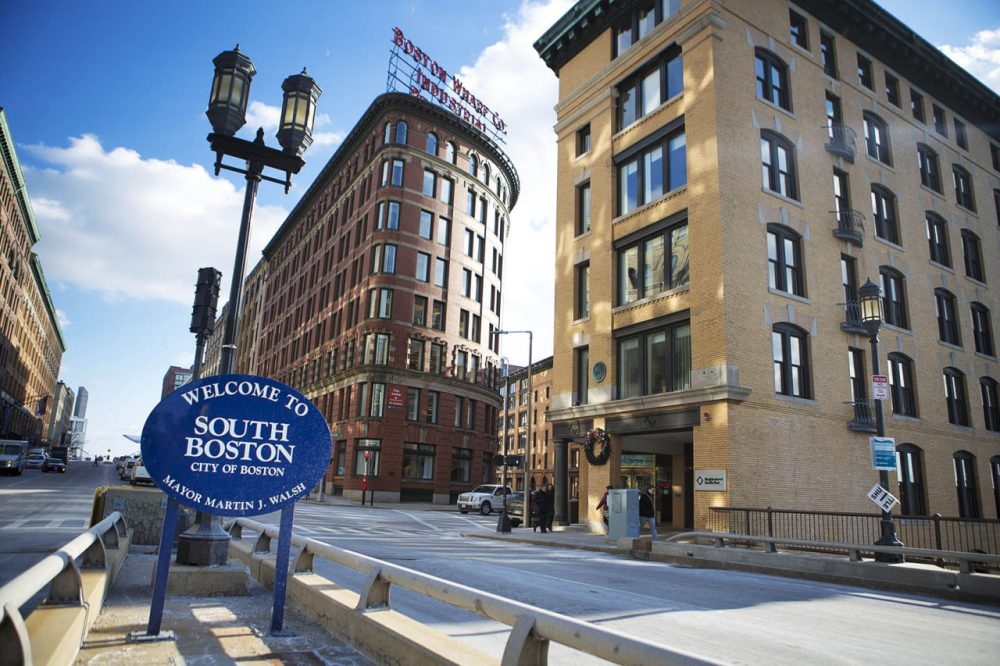Advertisement
General Electric Leaves The Suburbs For The City, Reversing An Old Trend
Resume
To understand why General Electric would abandon its sprawling Fairfield, Connecticut, campus, for Boston's waterfront, consider what one small, 30-person firm is looking for as it seeks out office space in the same neighborhood: showers.
"Because a lot of people are biking to work," explained real estate broker Greg Hoffmeister. "They want to have that, or go running at lunch. So having a shower is pretty important."
Today’s knowledge workers want bike racks and subway stops, not country clubs and parking garages. GE's decision to move its corporate headquarters to Boston is part of a larger business trend of leaving the suburbs for the city.
More Important Than Tax Breaks
A couple dozen employees have gathered at a sales training for the Boston startup EverTrue. No one here is over 30 years old except for Chief Operating Officer Elisabeth Bentel Carpenter. As two workers play ping pong, she says her young colleagues don’t want to spend their time commuting like she did when she was their age.
"They’ll leave at reasonable hours to do things that are important to them, whether it’s having dinner with friends, going to the gym, what have you," Bentel Carpenter said. "They tend to get back online later at night, because we have a lot of work to do. They’re just really ambitious, young go-getters."
It’s these young go-getters who General Electric wants to have in its neighborhood and working for the company. In a statement announcing the move, CEO Jeff Immelt cited Massachusetts’ record spending on research and development.
"GE recognizes the innovation in our city, the educational institutions in our city, the diversity in our city, the people in our city, and we’re excited about this."
Mayor Marty Walsh
"GE recognizes the innovation in our city, the educational institutions in our city, the diversity in our city, the people in our city, and we’re excited about this," Mayor Marty Walsh said after finding out about GE's move.
Another key to luring GE was the 15-minute drive from the waterfront to Logan International Airport. You don’t get nonstop flights from Hong Kong to the suburbs.
Boston’s economic development chief, John Barros, says that’s critical for a company with 300,000 workers in more than 170 countries.
"We added everything in the proposal: everything from access to the airport and different things like hangars for GE," Barros said. "For a corporation like GE, you have to discuss things like helipads."
Those selling points turned out to be more important than tax breaks.
Reversing An Old Trend
Labor market economist Enrico Moretti at UC Berkeley says GE’s move is reversing an old trend. Companies left troubled cities in the 1970s and '80s for manicured suburban office parks. Now they’re moving back into revitalized urban centers.
"We see similar dynamics at play in Silicon Valley," Moretti said. "But we see the same trends in other cities, from Seattle to Austin to Raleigh-Durham."
Hoffmeister, the commercial real estate broker, agrees. His firm, T3 Advisors, moved from Waltham into Boston two-and-a-half years ago.
"To me, it’s the Big Dig and the Greenway getting established, and sort of the beautification of the waterfront connecting to the Financial District," Hoffmeister said. "All of a sudden it just becomes a livable city, more than it was in the past. It all sort of comes together as work-play-live. Boston’s right there taking advantage of it."
In some ways, General Electric is returning to its roots. The Seaport District is not unlike the riverfront industrial district of Schenectady, New York, the location of the first headquarters of Edison General Electric Company back in 1892.
Alex Howley works for a much newer company in the Seaport with a similar name, General Assembly.
"I love this area!" Howley said. "All these gorgeous like old manufacturing buildings with the exposed brick, like these loft-style places. It’s gorgeous. I’m obsessed."
First-time entrepreneur Brent Grinna, EverTrue's CEO, says his generation wants the same thing as America’s corporate leaders.
"We want to work near where we live. And we just prefer living in the North End or South Boston. Where we live is different. And where we work is catching up."
EverTrue CEO Brent Grinna
"We want to work near where we live," Grinna said. "And we just prefer living in the North End or South Boston. Where we live is different. And where we work is catching up."
If corporate managers haven’t noticed yet, they will now. General Electric has been able to stay an industrial giant for more than a century by changing with the times. Its move to Boston shows where it thinks the future will be made.
This segment aired on January 15, 2016.
